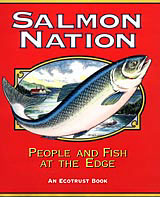fishing
-
Why hasn't the National Marine Fisheries Service called for Snake River dams?
Passions run high in the Pacific Northwest over whether to remove four large federal dams on the lower Snake River to recover the river’s imperiled wild salmon and steelhead (a.k.a. sea-run rainbow trout). The Snake once produced more salmon and steelhead than any other river in the vast Columbia River basin — over 2 million […]
-
Kris Williams is saving sea turtles in Georgia
Kris Williams is the “Turtle Babe” of Wassaw Island. At 33, the attractive, square-jawed blonde heads the oldest volunteer-based sea turtle conservation project in North America. What a babe. Optimism comes as naturally to Williams as the tide comes to the beach. It has to, because sea turtle conservation in Georgia isn’t easy. “Awareness is […]
-
Sea turtle activists are pushing for protections in Texas
They may be swimming against the current, but sea turtle advocates say they want Gov. George W. Bush (R) to show a little of his fabled compassion for the endangered reptiles that frequent the Gulf of Mexico along the Texas coast. The New York Times ad. Image: STRP. As the GOP presidential hopeful prepared to […]
-
What's killing off lobsters in Long Island Sound?
Richard A. French, a specialist in animal disease at the University of Connecticut, often comes to work wearing a lobster tie tack he bought at a shellfish conference. He’s had lobsters on the brain lately, particularly the mystery of why hundreds of thousands of lobsters have died within the last year in Long Island Sound. […]
-
Atlantic salmon are even worse off than their Pacific cousins
To catch an Atlantic salmon in the Machias River back in the 1940s — and we’re talking a legitimate salmon here, maybe 30 or 40 pounds — didn’t require a knack with rod and reel, nor even the wily patience of the angler. Mostly what you needed was decent aim with a rifle or pitchfork […]
-
Do you know where your salmon comes from?
Thirty percent of the world's salmon now come from hatcheries, but wild fish account for only another twenty to thirty percent. Almost all of those wild fish come from waters around Alaska and British Columbia, northern waters where runs are mostly intact. These are the waters from which we harvest volumes comparable to those native people caught for thousands of years, that is, in those places largely unmanaged. The biggest share of the world's salmon consumption, however -- now forty to fifty percent -- comes from farmed fish, salmon raised and fed artificially in net pens their entire lives.
-
Are efforts to protect the dolphin putting other fish in a sea of trouble?
There were predictable cries of protest from some conservationists who focus on charismatic megafauna when revised standards for use of the “dolphin safe” tuna label were announced by the Commerce Department in April. Though the new rules stipulate that no dolphins should be killed or seriously injured, they do let canners label their product “dolphin […]
-
A Tale of Two Fisheries
At the beginning of this millennium, the Norse began to fish what is now called the Grand Banks off the coast of Newfoundland. In 1501, the Company of Adventurers to the New Found Lands was chartered in England to make summer expeditions to that rich fishing ground. For the next 500 years, the Grand Banks […]

